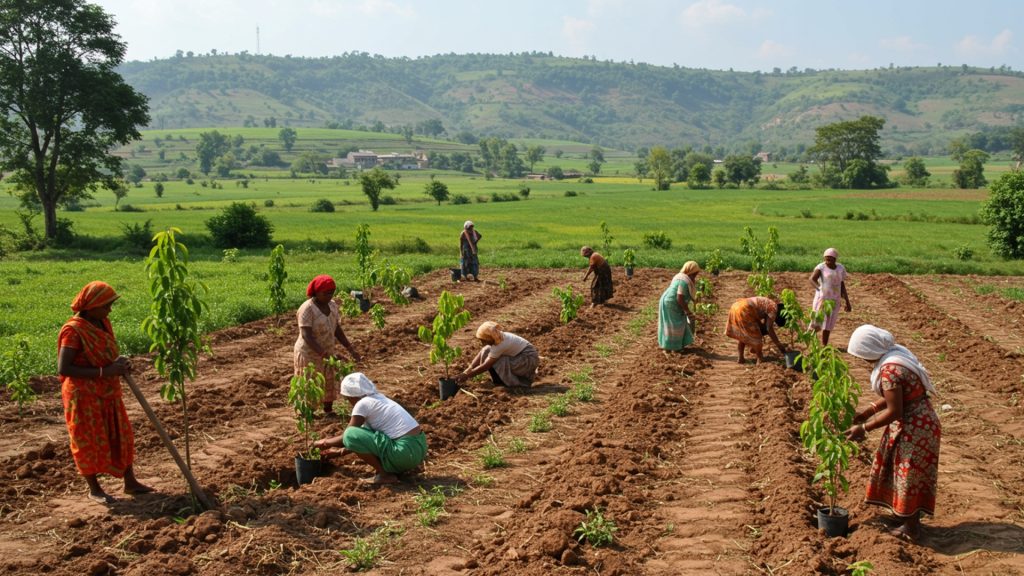Jharkhand today launches an ambitious green drive, planting millions of fruit trees across the state. This massive effort immediately begins transforming vast land areas, aiming to fight climate change and boost the lives of countless families. By putting millions of fruit-bearing trees into the ground, the state government plans to make the land greener and give people new sources of food and money. This move marks a big step for a healthier environment and a better future for many in the region.
Expanding Green Spaces and Local Income
Jharkhand has started a large program to plant millions of fruit trees across the state. This effort aims to make the state greener and help people in villages earn more money. The plan is part of a bigger push to improve the environment and give new ways for people to make a living. Rapid cutting down of trees is a worry around the world. Jharkhand is working to find a balance between its industrial activities and keeping its forests healthy. Forests cover about 28 percent of the state’s land.
Supporting Rural Families
At the center of this big planting effort is the Birsa Harit Gram Yojana (BHGY). This scheme was first launched in the financial year 2016-17 by the state’s rural development department. It works under the central government’s Mahatma Gandhi National Rural Employment Guarantee Scheme (MGNREGS). The program was renamed and started again in 2020, during the time of the COVID-19 health crisis. Its goal was to help many thousands of migrant workers from the state who had to come back home with no jobs.
Since its relaunch, the Birsa Harit Gram Yojana has helped over 1. 67 lakh families by encouraging them to grow fruit trees on unused land. This has given a much-needed lifeline to people in the villages.
The scheme helps people turn empty land into fruit farms. Those who work on preparing the land get paid wages through MGNREGS. Later, they also get tree saplings, fertilizers. expert help.
“The scheme was made to help MGNREGS workers become owners of their own fruit farms,” said Mr. Mritunjay Kumar Barnwal, the Jharkhand MGNREGA Commissioner. “They earn money while preparing their land and also create a lasting asset. Until the fruit trees start giving fruit, they grow vegetables and sell them to earn money.”
Millions of Trees, Many Kinds
The planting started with high-quality mango varieties like Amrapali and Mallika in some areas of Khunti district. The plan is to add other valuable fruits like litchi and cashew nuts in the coming years. In addition to fruit trees, timber trees such as teak, Indian rosewood. mahogany are also being planted. These timber trees can help families financially in the long run.
As of now, about 2. 17 crore (21. 7 million) saplings have been planted across the state under this scheme. What began with planting on a few hundred acres in 2016-17 has now changed 1. 49 lakh (149,000) acres of unused land in nine years. For the current financial year, the department aims to change 50,000 more acres into green areas and plant 1 crore (10 million) saplings.
The state government also has a big aim to make “one plant, one person” a reality by the end of the current financial year.
| Tree Type | Examples | Primary Benefit |
|---|---|---|
| Fruit Trees | Mango (Amrapali, Mallika), Guava, Litchi, Jackfruit, Cashew | Food, Income for families |
| Timber Trees | Teak, Indian Rosewood, Mahogany | Long-term income for families |
| Flower Trees | Jasmine, Marigold | Beautification |
Training and Community Help
To make sure the newly planted trees are cared for properly, the department has trained more than 15,000 ‘Bagwani Sakhis’. These are women from villages who have learned about growing plants, how to take care of trees. how the scheme works. This system, based in the community, helps share knowledge and makes sure the tree planting is successful.
The Directorate of Horticulture has also trained District Horticulture Officers and scientists from farming advice centers in all 24 districts of the state. They have created standard teaching plans that can be used again in other training workshops.
Wider Green Efforts
This fruit tree drive is part of Jharkhand’s broader efforts to improve its green cover. The state has launched various initiatives aimed at increasing plantations on government lands and promoting environmental awareness. For example, the Jharkhand Assembly complex itself is being developed into a fruit orchard with more than 60 acres of land. In this area, over 650 trees, including six types of mangoes, guava, litchi. jackfruit, were planted.
“It is an effort to make the orchard earn money so that the funds generated from selling fruits can be used for the Assembly’s upkeep,” said Speaker Rabindra Nath Mahto.
The state forest department has also had targets for planting a large number of saplings, for instance, setting a goal of 1. 67 crore saplings during Van Mahotsav. There have been efforts to distribute fruit-bearing trees for free to people, especially those from poorer sections of society and those who want to grow fruit farms. The education department has also asked schools to carry out tree plantation programs, encouraging students to plant fruit and flower trees inside school grounds.
Facing Environmental Challenges
Jharkhand faces challenges like low underground water levels and is working to address these through tree planting. The state is also focusing on water saving plans, including building check dams and small natural wells. These actions show the state’s strong commitment to dealing with environmental changes and making a green, healthy future for its people.
Experts note that climate change is a serious problem that needs everyone to work together. By using methods that are good for the environment and respecting old knowledge about nature, it is possible to create a lively and healthy future for all living things.

